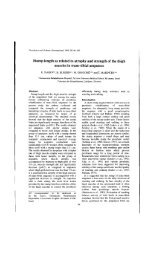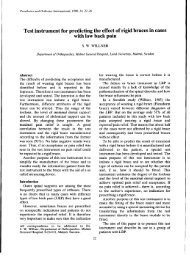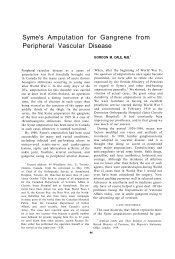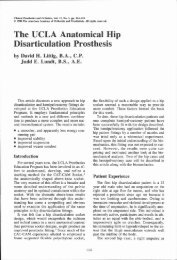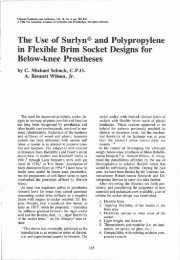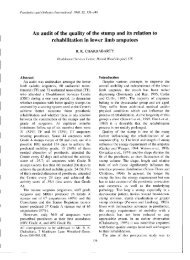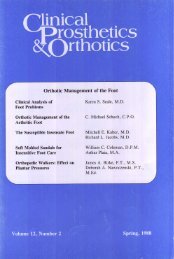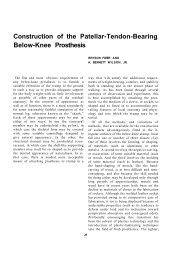The Biomechanics of Control in Upper-Extremity Prostheses
The Biomechanics of Control in Upper-Extremity Prostheses
The Biomechanics of Control in Upper-Extremity Prostheses
Create successful ePaper yourself
Turn your PDF publications into a flip-book with our unique Google optimized e-Paper software.
clavicle, and the proximal end <strong>of</strong><br />
the humerus. Anteriorly the lower<br />
fibers <strong>of</strong> the pectoralis major, the<br />
pectoralis m<strong>in</strong>or, and the subclavius,<br />
and posteriorly the lower<br />
trapezius and latissimus, act as<br />
depressors.<br />
Rotation <strong>of</strong> the scapula upward<br />
(i.e., right scapula, viewed from<br />
the rear, rotates counterclockwise)<br />
or downward (i.e., right scapula,<br />
viewed from the rear, rotates<br />
clockwise) is brought about by a<br />
special comb<strong>in</strong>ation <strong>of</strong> the elevators<br />
and depressors. As shown <strong>in</strong><br />
Figure 6, two portions <strong>of</strong> the trapezius,<br />
together with the serratus,<br />
cause upward rotation. Conversely,<br />
the pectorals, the latissimus, and<br />
the rhomboids cooperate to cause<br />
downward rotation. As will be seen<br />
later (page 13), the mechanical<br />
pr<strong>in</strong>ciple <strong>of</strong> the couple applies <strong>in</strong><br />
these rotatory actions upon the<br />
scapula.<br />
Flexion and extension <strong>of</strong> the<br />
shoulder <strong>in</strong>volve as pr<strong>in</strong>cipal elements<br />
the abduction and adduction, respectively,<br />
<strong>of</strong> the scapula. <strong>The</strong> flexor muscles act<strong>in</strong>g<br />
on the shoulder complex are the pectoralis<br />
major and m<strong>in</strong>or, which sw<strong>in</strong>g the clavicle and<br />
acromion forward. <strong>The</strong> serratus anterior aids<br />
strongly by abduct<strong>in</strong>g the scapula. <strong>The</strong> extensors,<br />
placed posteriorly, <strong>in</strong>clude the latissimus,<br />
which pulls posteriorly and medially on the<br />
humerus, and the trapezius and rhomboids,<br />
which pull medially on the scapula.<br />
<strong>The</strong> forward and backward shrugg<strong>in</strong>g <strong>of</strong> the<br />
shoulders with abduction and adduction, together<br />
with some upward and downward<br />
rotation <strong>of</strong> the scapulae, constitutes a major<br />
control source. Even <strong>in</strong> above-elbow amputees<br />
who use humeral flexion for forearm lift and<br />
for term<strong>in</strong>al-device operation at low elbow<br />
angles (page 22), scapular abduction is<br />
utilized for term<strong>in</strong>al-device operation at<br />
large angles <strong>of</strong> elbow flexion (e.g., when the<br />
term<strong>in</strong>al device is near the mouth). In shoulder<br />
amputees, both these operations depend<br />
wholly upon scapular abduction augmented by<br />
upward rotation.<br />
BIOMECHANICS OF CONTROL 9<br />
Fig. 5. Skeletal anatomy <strong>of</strong> the shoulder region, a, Anterior view.<br />
b, Posterior view.<br />
THE ARM<br />
<strong>The</strong> Humerus and the Glenohumeral Jo<strong>in</strong>t<br />
<strong>The</strong> humerus, together with its jo<strong>in</strong>t at the<br />
shoulder, comprises the skeletal mach<strong>in</strong>ery <strong>of</strong><br />
the arm. As noted <strong>in</strong> Figure 4, it is capable <strong>of</strong><br />
flexion-extension, elevation-depression, and<br />
rotation upon its proximal jo<strong>in</strong>t. <strong>The</strong> glenoid<br />
cavity, a lateral process on the scapula, receives<br />
the spherical surface <strong>of</strong> the humeral<br />
head. <strong>The</strong> glenohumeral articulation is therefore<br />
<strong>of</strong> true ball-and-socket character. <strong>The</strong><br />
fibrous jo<strong>in</strong>t capsule is remarkable <strong>in</strong> that it<br />
envelops the humeral head and the glenoid<br />
marg<strong>in</strong>s <strong>in</strong> complete but rather loose fashion,<br />
so that a wide range <strong>of</strong> movement is possible.<br />
To some extent barometric pressure, but to<br />
larger extent the musculature spann<strong>in</strong>g the<br />
jo<strong>in</strong>t, is responsible for keep<strong>in</strong>g the articular<br />
surfaces together <strong>in</strong> all angular positions. A<br />
group <strong>of</strong> muscles <strong>in</strong>clud<strong>in</strong>g the subscapularis,<br />
the suprasp<strong>in</strong>atus, and the <strong>in</strong>frasp<strong>in</strong>atus function<br />
pr<strong>in</strong>cipally <strong>in</strong> this hold<strong>in</strong>g action.



